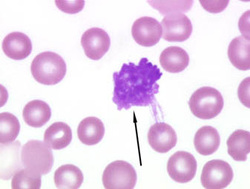|
|
Pathology definition - Chronic Lymphocytic Leukemia

Chronic Lymphocytic Leukemia
Chronic lymphocytic leukemia may present with signs and symptoms such as fatigue, enlargement of the spleen and enlargement of the liver ( hepatosplenomegaly), mucosal bleeding and lymphadenopathy.
Chronic lymphocytic leukemia is commonly affecting elderly individuals age 60 and above. Chronic lymphocytic leukemia is not curative in nature.The aim of the treatment is focusing on symptomatic relief. Chemotherapy is considered in patient who suffer from chronic lymphocytic leukemia.
Chronic lymphocytic leukemia commonly associated with chromosomal abnormalities. The chromosomal abnormalities may include deletion of the 11q, trisomy 12 and deletion of the 13 q) Deletion of the 11q and 13 q mean the deletion of the long arm chromosome no 11 and 13.
Peripheral blood film/peripheral blood smear may reveal normochromic normocytic erythrocytes, lymphocytosis and the present of smudge cells. Smudge cells are leukemic cells. These leukemic cells are sensitive to disruption mechanically during the preparation of the slide for microscopy evaluation. Bone marrow analysis may reveal infiltration of the small lymphocytic cells which look like normal mature B lymphocytes. They will express CD5 that is commonly present in T lymphocytes.
The complication of chronic lymphocytic leukemia may include warm autoimmune hemolytic anemia ( AIHA) and increased the risk of infection due to hypogammaglobulinemia.
References
1.Chiorazzi, Nicholas, Kanti R. Rai, and Manlio Ferrarini. “Chronic Lymphocytic Leukemia.” New England Journal of Medicine 352, no. 8 (2005): 804–815. doi:10.1056/NEJMra041720.
2.Keating, M J. “Chronic Lymphocytic Leukemia.” Seminars in Oncology 26, no. 5 Suppl 14 (October 1999): 107–114.
Chronic lymphocytic leukemia may present with signs and symptoms such as fatigue, enlargement of the spleen and enlargement of the liver ( hepatosplenomegaly), mucosal bleeding and lymphadenopathy.
Chronic lymphocytic leukemia is commonly affecting elderly individuals age 60 and above. Chronic lymphocytic leukemia is not curative in nature.The aim of the treatment is focusing on symptomatic relief. Chemotherapy is considered in patient who suffer from chronic lymphocytic leukemia.
Chronic lymphocytic leukemia commonly associated with chromosomal abnormalities. The chromosomal abnormalities may include deletion of the 11q, trisomy 12 and deletion of the 13 q) Deletion of the 11q and 13 q mean the deletion of the long arm chromosome no 11 and 13.
Peripheral blood film/peripheral blood smear may reveal normochromic normocytic erythrocytes, lymphocytosis and the present of smudge cells. Smudge cells are leukemic cells. These leukemic cells are sensitive to disruption mechanically during the preparation of the slide for microscopy evaluation. Bone marrow analysis may reveal infiltration of the small lymphocytic cells which look like normal mature B lymphocytes. They will express CD5 that is commonly present in T lymphocytes.
The complication of chronic lymphocytic leukemia may include warm autoimmune hemolytic anemia ( AIHA) and increased the risk of infection due to hypogammaglobulinemia.
References
1.Chiorazzi, Nicholas, Kanti R. Rai, and Manlio Ferrarini. “Chronic Lymphocytic Leukemia.” New England Journal of Medicine 352, no. 8 (2005): 804–815. doi:10.1056/NEJMra041720.
2.Keating, M J. “Chronic Lymphocytic Leukemia.” Seminars in Oncology 26, no. 5 Suppl 14 (October 1999): 107–114.
